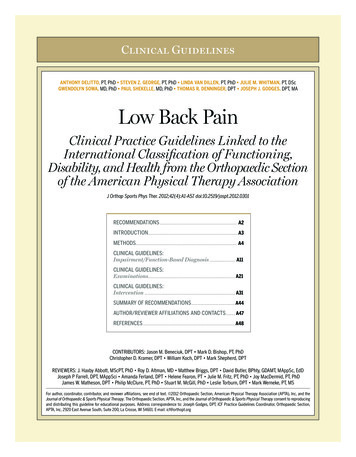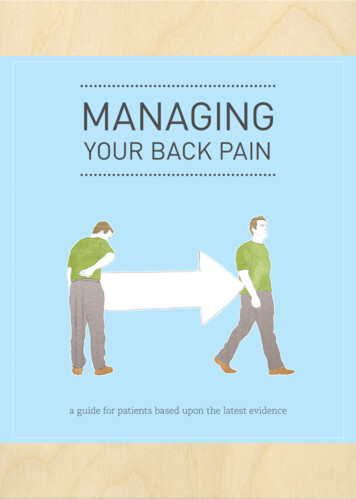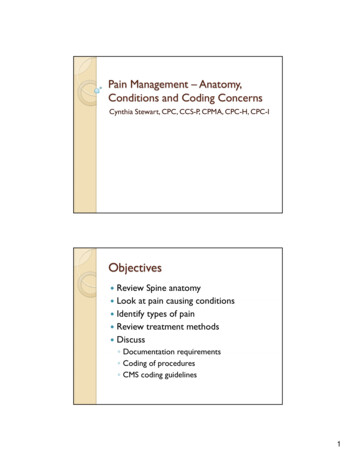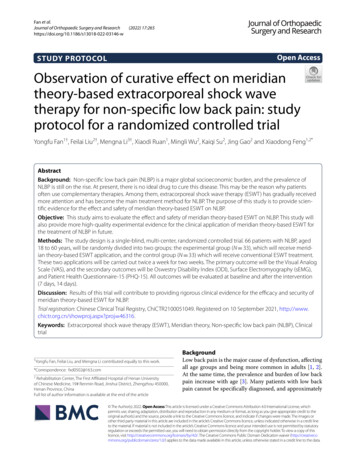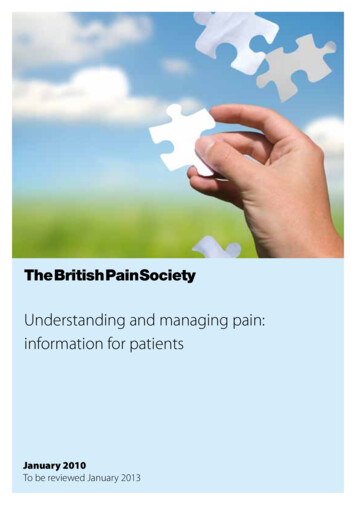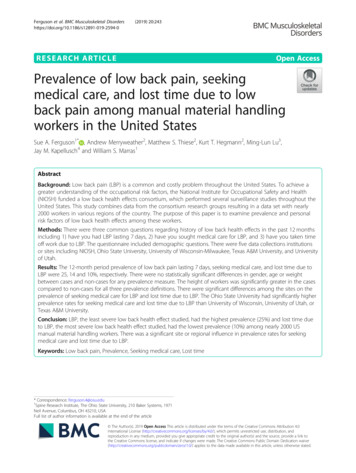
Transcription
Ferguson et al. BMC Musculoskeletal (2019) 20:243RESEARCH ARTICLEOpen AccessPrevalence of low back pain, seekingmedical care, and lost time due to lowback pain among manual material handlingworkers in the United StatesSue A. Ferguson1* , Andrew Merryweather2, Matthew S. Thiese2, Kurt T. Hegmann2, Ming-Lun Lu3,Jay M. Kapellusch4 and William S. Marras1AbstractBackground: Low back pain (LBP) is a common and costly problem throughout the United States. To achieve agreater understanding of the occupational risk factors, the National Institute for Occupational Safety and Health(NIOSH) funded a low back health effects consortium, which performed several surveillance studies throughout theUnited States. This study combines data from the consortium research groups resulting in a data set with nearly2000 workers in various regions of the country. The purpose of this paper is to examine prevalence and personalrisk factors of low back health effects among these workers.Methods: There were three common questions regarding history of low back health effects in the past 12 monthsincluding 1) have you had LBP lasting 7 days, 2) have you sought medical care for LBP, and 3) have you taken timeoff work due to LBP. The questionnaire included demographic questions. There were five data collections institutionsor sites including NIOSH, Ohio State University, University of Wisconsin-Milwaukee, Texas A&M University, and Universityof Utah.Results: The 12-month period prevalence of low back pain lasting 7 days, seeking medical care, and lost time due toLBP were 25, 14 and 10%, respectively. There were no statistically significant differences in gender, age or weightbetween cases and non-cases for any prevalence measure. The height of workers was significantly greater in the casescompared to non-cases for all three prevalence definitions. There were significant differences among the sites on theprevalence of seeking medical care for LBP and lost time due to LBP. The Ohio State University had significantly higherprevalence rates for seeking medical care and lost time due to LBP than University of Wisconsin, University of Utah, orTexas A&M University.Conclusion: LBP, the least severe low back health effect studied, had the highest prevalence (25%) and lost time dueto LBP, the most severe low back health effect studied, had the lowest prevalence (10%) among nearly 2000 USmanual material handling workers. There was a significant site or regional influence in prevalence rates for seekingmedical care and lost time due to LBP.Keywords: Low back pain, Prevalence, Seeking medical care, Lost time* Correspondence: ferguson.4@osu.edu1Spine Research Institute, The Ohio State University, 210 Baker Systems, 1971Neil Avenue, Columbus, OH 43210, USAFull list of author information is available at the end of the article The Author(s). 2019 Open Access This article is distributed under the terms of the Creative Commons Attribution 4.0International License (http://creativecommons.org/licenses/by/4.0/), which permits unrestricted use, distribution, andreproduction in any medium, provided you give appropriate credit to the original author(s) and the source, provide a link tothe Creative Commons license, and indicate if changes were made. The Creative Commons Public Domain Dedication o/1.0/) applies to the data made available in this article, unless otherwise stated.
Ferguson et al. BMC Musculoskeletal Disorders(2019) 20:243BackgroundLow back pain is a leading cause of disability worldwide[1]. There are several surveillance measures that havebeen used in the literature to investigate prevalence ratesand risk factors for low back health effects includingpresence of LBP of any severity, LBP that resulted in theseeking of medical care, and LBP resulting in lost timefrom work. Reported LBP prevalence rates range from4% [2] to 69% [3, 4] and vary depending on the length oftime evaluated (e.g., lifetime, 1-month and point prevalence [5] as well as pain intensity [6]). LBP resulting inseeking medical care has reported prevalence rates ranging from 4.5% [7] to 32% [8] and has been shown to beinfluenced by the length of time of symptoms [9], gender[10] and race/ethnicity [10]. Taking time off from work,or lost time, is the least commonly used surveillancemeasure for low back health effects in the literature [11]and has prevalence rates between 4.6% [12] to 18% [13,14]. These surveillance measures for low back healthmay represent a series of cascading events that start withmild LBP, which perhaps leads to an individual seekingmedical care for LBP, possibly progressing to taking timeoff work for LBP that may recur any number of timesand culminate with disabling LBP [15]. It is theorizedthat evaluating these three surveillance measures in alarge population may provide further insight into theprogression and potential prevention of LBP leading todisability.A few studies have examined prevalence rates amongworkers using surveillance measures of LBP, seeking medical care for LBP and lost work time due to LBP. Ozgularet al. [6] examined prevalence of LBP in 725 activeworkers (office, hospital, warehouse, and airport registration of luggage) using LBP lasting at least 1 day, LBP withhealth care professional visit(s), and LBP with the takingof sick leave. The results showed a 1 day prevalence of43%, seeking medical care prevalence rate of 22%, andLBP with sick leave of 9% [6]. Merlino et al. [16] examinedmusculoskeletal disorders among 996 apprentice construction workers and found that in the past 12 monthsthe prevalence for LBP symptoms was 54%, seeking medical care prevalence was 17%, and missed work prevalencewas 7%. Feng et al. [17] evaluated a group of 244 Taiwanese nurses and nursing staff and reported 66% prevalenceof LBP lasting at least 1 day, 38% seeking medical care forLBP, and 11% with sick leave for LBP in the past 12months. Abolfotouh et al. [13] examined several low backprevalence measures among a population of 254 nurses inDoha, Qatar. The 12 month period prevalence for LBPlasting at least 1 day was 54%, prevalence for seekingtreatment due to LBP was 34%, and sick leave or lost timefor LBP prevalence was 18% [13].Thus, there is a wide range of prevalence rates for lowback health effects. These prevalence rates may bePage 2 of 8influenced by the length of time as well as the severityof low back health effect definition investigated, i.e. LBP,seeking medical care for LBP or lost work time for LBP.There is a lack of studies examining the prevalence oflow back health effects using multiple definitions in alarge occupational population in the United States. Theobjective of this study was two-fold 1) to combine datafrom several studies and examine the differences inprevalence of LBP, seeking medical care for LBP, and losttime due to LBP among a large population of US manualmaterial handling workers and 2) to examine differencesamong personal risk factors for each prevalencemeasure.Methods/designThis was a cross-sectional study design that combineddata from several epidemiological studies that examinedwork related low back health. It is hypothesized thatthere will be differences in the prevalence rates amongthe three definitions of LBP furthermore this will resultin differences among personal risk factors for the prevalence measures. The LBP research consortium included5 members: 1) National institute of Occupational Safetyand Health (NIOSH) 2) Ohio State University (OSU), 3)University of Wisconsin-Milwaukee (UWM), 4) TexasA&M University (TAMU), and 5) University of Utah(UU). The individual consortium study findings havebeen previously published [5, 18–20]. All studies wereapproved by the respective institutional review boards(IRBs). The University of Wisconsin IRB had oversite forthe merging of anonymized datasets.Convenience samples of workers were enrolled fromsix US states: Illinois, Michigan, Ohio, Texas, Utah andWisconsin. The NIOSH data was collected at a largedryer manufacturing facility in the state of Ohio. TheOSU team collected data in 20 distribution centers inOhio and 1 office furniture distribution center in Michigan. The 20 distribution centers were in one of four categories including automotive parts, grocery, apparel andgeneral merchandise. The UU data was collected in thestate of Utah in a variety of manufacturing facilities including medical products, apparel, cabinetry, salt andauto parts manufacturers as well as an alcohol distribution center and printing operations. The TAMU groupcollected data primarily at meat packing and grocerywarehouse facilities and one upholstery facility in thestate of Texas. The UWM data was collected in 15 facilities in the state of Wisconsin and one facility in thestate of Illinois, and consisted of manufacturing and distribution facilities including automotive, apparel, windowand door, food and beverage, household items, pharmaceutical and general merchandise. At all sites the inclusion criterion was the manual material handling job atthe facility that the workers performed. Workers on a
Ferguson et al. BMC Musculoskeletal Disorders(2019) 20:243job of interest were recruited by a research team member. Researchers encouraged all workers on the job ofinterest to participate regardless of health issues. The exclusion criterion was working at the facility on a jobwithout manual material handling tasks of interest. Allworkers signed a human subject’s consent form prior toparticipating in the study. All data was collected at therespective work facilities resulting in a variety of occupational study settings. Participating employees receivedtheir regular wages during the study. All workers participating in the study received questionnaires that includeddemographic information (e.g., age, gender, race/ethnicity, height, weight) and cigarette usage. The questionnaires also included questions about low back healtheffects due to participants’ jobs. Table 1 lists the specificquestions regarding low back health effects.The merged database had three categories of variablesincluding 1) health effects and personal risk factors, 2)psychosocial exposure and 3) physical exposure measures. This analysis was only on prevalence of low backhealth effects and personal risk factors. Only subjectswith complete baseline data for health effects and personal factors were eligible for prevalence analysis. Dataanalyses were initiated for the seeking of medical carequestion by dichotomization into either seeking medicalcare or not seeking medical care. Similarly, the missedwork question was dichotomized into either no missedworkdays or missed workdays. Statistical analyses wereperformed using SAS version 9.2. Descriptive statisticswere calculated for the number of cases for each lowback health effect definition and demographic information. To test for differences in the prevalence ratesamong the three outcome measures McNemar’s Testswere performed. For continuous measures of age,weight, and height, T-tests were run for each case definition. To examine risk factor differences among the threeprevalence measures general linear models (proc GLM)were utilized. Test statements were employed to evaluatedifferences due to consortium study site, gender, race/ethnicity, and site by race/ethnicity interaction. Post hocRyan-Einot-Gabriel-Welsch REGWQ multiple rangeTable 1 Research questions utilized to measure low back healtheffectsQuestions for low back health effect.1. In the past 12 months, have you had back pain every day for a week(7 days) or more?2. In the past 12 months, how many times have you seen a doctor,nurse, physical therapist or chiropractor or other health care providerfor your back symptoms?3. How many days have you missed work in the past 12 monthsbecause ofback symptoms?Page 3 of 8tests were used to determine significant differencesamong the sites and race/ethnicity.ResultsThe combined total sample from all the consortium siteswas 1976 workers and, of those, 1929 completed theminimum baseline data requirements for inclusion inthe prevalence analysis. Table 2 lists total population,cases, and prevalence for the three measures of low backhealth effects. Prevalence rates for LBP lasting at least 1week, seeking medical care, and lost time due to LBPwere 25, 14, and 10%, respectively. McNemar’s test statistics for LBP lasting 1 week vs. seeking medical carewas 211.5 and p-value 0.0001. Prevalence of low backpain lasting at least 1 week vs. lost time due to LBP wasa McNemar’s test statistic of 242.5 and p-value 0.001.Finally the McNemar’s test statistic for seeking medicalcare vs. lost time due to LBP was 31.1 and p-value 0.0001. Thus, the null hypothesis that the distributionsare the same was rejected and therefore, each prevalencedefinition resulted in a significantly different prevalencerate for the same 1 year period.Seventy-five percent of the participants were male. Theaverage age, weight, and height of the study populationare listed in Table 3. The race/ethnicity of the 1929workers was 1253 (65%) white, 275 (14%) Hispanic/Latino,269 (14%) black/African American, 52 (3%) Asian, 47 (2%)Native Hawaiian or Pacific Islanders, and 3 ( 1%) NativeAmerican or Native Alaskan and 30 (2%) declined to respond or were other. Nearly half of the 1929 (n 956,49%) of the workers had never smoked.Table 3 lists the means and standard deviations forage, weight, and height for cases and non-cases for eachdefinition of low back health effect and indicators forsignificant differences. There was no difference in age orweight between cases and non-cases. Worker staturewas significantly different between the cases and thenon-cases for all three prevalence measures. Workerswith low back health effects were approximately 2.0 cmtaller than the workers without.The general linear model test statement results indicatedno significant differences for gender or race for any of thelow back health effect prevalence measures. The test statement evaluating differences among the sites varied as afunction of the definition of low back health effect. Theprevalence measure of LBP lasting at least 1 week showedno statistically significant differences among the sites (datanot shown). Conversely, the seeking medical care for LBPprevalence measure showed significant differences amongthe sites (p 0.001). Figure 1 illustrates the 12-monthperiod prevalence among the different sites. The differentletters above the bars in the chart indicate statistically significant differences among the sites from the post hocREGWQ test results. The OSU site had a significantly
Ferguson et al. BMC Musculoskeletal Disorders(2019) 20:243Page 4 of 8Table 2 Cases and prevalence as a function of low back health effect definitionLow Back Health Effect DefinitionCasesLow Back Pain lasting at least one weekSeeking Medical Care for LBPLost Work Time for LBP483272192Population of Workers192919271929Prevalence25%14%10%greater 12-month period prevalence rate at slightly over25% than all other sites, as indicated in Fig. 1 by the letterA above the bar. NIOSH had a statistically significant lower12-month period prevalence of seeking medical care compared to OSU (indicated by the letter B in Fig. 1 above thebar) and a significantly greater 12-month period prevalencein LBP with seeking medical care compared to UWM, UU,and TAMU. There was no difference in seeking medicalcare 12-month period prevalence among UWM, UU, andTAMU, as indicated in Fig. 1 by the letter C above the barsfor the three sites.The general linear model also showed a statistically significant difference among the sites for lost time due toLBP (p 0.05). Figure 2 illustrates the differences in losttime due to LBP prevalence among the sites. The lettersabove the bars indicate statistical differences from the posthoc REGWQ test results. The OSU data had the highest12-month period prevalence at approximately 16% for losttime due to LBP. There was no significant difference between OSU and NIOSH at 12% in lost time as indicatedwith the letter A above both bars, but OSU had significantly higher lost time 12-month period prevalence thanthe other three sites. Figure 2 illustrates with the letter Babove both bars that there was no significant differencebetween NIOSH and TAMU at 6% lost time prevalence.Table 3 T-test results for continuous demographic measuresmeans (standard deviation) between cases and non-cases bylow back health effect definitionTotal SampleAge (years)Weight (kg)Height (cm)36.2 (11.6)84.8 (20.9)173.2 (10.2)85.2 (19.5)174.5 (9.6)Low Back Pain 7 daysCases36.6 (11.7)Non Cases36.1 (11.5)84.6 (21.4)172.7 (10.4)p-values0.40310.48400.0004*85.6 (19.0)175.5 (9.4)Seeking Medical Care for LBPCases35.8 (10.9)Non Cases36.3 (11.6)84.6 (21.2)172.7 (10.4)p-values0.55860.47150.0001*85.3 (19.0)175.0 (9.1)Lost Work Time for LBPCases35.0 (10.9)Non Cases36.4 (11.6)84.7 (21.1)173.0 (10.4)p-values0.11910.74090.0039*Note: * indicates statistical significanceFinally, there was no significant difference in lost timeprevalence among UWM, UU, and TAMU, as shown inFig. 2 with the letter C above all three sites.DiscussionThe principal finding of this research was that prevalence rates of low back health effects in the past 12month period varied dramatically as a function of thethree definitions in a large population of US workers.The prevalence rates for LBP lasting at least 1 week,seeking medical care, and lost time due to LBP were 25,14 and 10%, respectively. McNemar’s test showed thateach of the three prevalence rates were statistically significantly different from one another. Worker staturewas the only personal risk factor that was significantlydifferent between cases and non-cases among the threeprevalence measures, and that average difference wassmall (i.e., cases approximately 2 cm taller thannon-cases).One of the strengths of the current study was thenearly 2000 workers that participated from six US states.This is the largest study of its kind that evaluated multiple definitions of low back health effects. Examiningthe prevalence rates with respect to the theory of cascading events [15], LBP the earliest surveillance measurestudied had the highest prevalence, progressing next tomedical visits there was a decrease in prevalence and finally to lost time due to LBP which had the lowestprevalence and presumed to be the most advanced or severe low back health effect in the progression. Thus, assurveillance measures for low back health effects progress in severity the prevalence rates decrease. Examining risk factors for each of these surveillance measuresmay provide insights into the prevention of chronic disabling LBP.The pattern of period prevalence rates in thecurrent study may be compared to other studies thatexamined all three prevalence measures. The currentstudy and the literature [6, 13, 16, 17] all similarly reported that LBP had the highest prevalence rate, thatthere was a decrease in the prevalence rates in all thestudies for seeking medical care, and that the lowestprevalence rate was for lost time due to LBP. Interestingly, two sites in this current study, UU andTAMU, had higher prevalence for lost time due toLBP than seeking medical care for LBP, which
Ferguson et al. BMC Musculoskeletal Disorders(2019) 20:243Page 5 of 8Fig. 1 Prevalence of seeking medical care for LBP in the past 12 months as a function of the study site. The bars with different letters above them are statisticallysignificantly difference from one another. Note: UWM University of Wisconsin, UU University of Utah, TAMU- Texas A&M University, NIOSH National Instituteof Occupational Safety and Health, OSU Ohio State Universitycontradicts the literature and the aforementioned theory of progression. These differences may be due to acombination of workers compensation insurance differences and/or cultural differences in seeking medicalcare for workplace injuries. The UU and TAMU pattern may also be due to factors not studied. One possible explanation for the lack of seeking care in Utahand Texas may be the lack of available health careproviders in the region. Combs et al. [21] reportedthat the ratio of primary care physician to population,which is how primary care physician availability hasbeen evaluated, was 63.4 in the state of Utah in 2008,which was the lowest among all 50 states. Gong et al.[22] found Texas to be one of the states with a severe physician shortage between 1999 and 2004. TheAmerican Association of Medical Colleges in 2007ranked all 50 states from highest to lowest on the ratio of physician to population, Texas and Utah wereamong the bottom 10 states on the ratio [23]. Thus itwas thought the low prevalence for seeking medicalcare in the UU and TAMU data may be due to thelack of availability of physicians in the regions wherethose data were collected. Alternatively, there may besufficient physicians in the region for healthcareneeds and instead some cultural differences not captured by ethnicity or other questions that promoteself-care instead of seeking care from a medical provider in the Utah and Texas regions, which may result in lower prevalence for seeking care compared tolost time due to LBP. Regardless, the overall trend inFig. 2 Prevalence of lost time for low back pain in the past 12 months as a function of the study site. The bars with different letters above themare statistically significantly difference from one another. Note: UWM University of Wisconsin, UU University of Utah, TAMU- Texas A&M University,NIOSH National Institute of Occupational Safety and Health, OSU Ohio State University
Ferguson et al. BMC Musculoskeletal Disorders(2019) 20:243the current study followed the pattern established inthe literature, which illustrates the strength of havinga large and diverse sample.The 12-month period prevalence rate of LBP lasting 7days or more in the current study was 25%. Both Abolfotough [13] and Feng [17] reported prevalence ratesmuch higher than the current study. It is hypothesizedthat the higher prevalence in the literature are due tothe one-day duration of symptoms compared to the7-day duration with the current study. This hypothesis issupported by Ozgular et al. [6], which reported a 1 dayLBP prevalence of 43% as well as a prevalence rate of17% for LBP lasting 30 days. Thus, for the shorter duration of pain symptoms the prevalence rate was higherthan the current study and for the longer 30 day duration of symptoms the prevalence was lower than thecurrent study.In the current study, the seeking medical care for LBPdefinition had a 12-month period prevalence of 14%.This prevalence rate is low in comparison to the literature, which ranges from 17 to 38%. In the report rankingthe ratio of physician to population [23] by state, Ohioand Michigan are at the average with 236.6 physiciansper 100,000 population and rank 17 and 18, respectively.The state of Illinois ranks 21, Wisconsin ranks 24. Thusnone of the participating states in the current study rankparticularly high on the physician to population ratioscale. This may be one explanation for why the seekingcare prevalence was lower in the current study compared to the literature. The Merlino study was completed in the United States with 17% prevalence. TheMerlino et al. [16] was collected in Iowa, Illinois, Oregonand Washington, which rank 41, 21, 13 and 16, respectively on the number of physicians per 100,000 in population in 2007. It may be that the increased availability inphysicians in Oregon and Washington resulted in an increased prevalence in the Merlino study compared tothe current study since both studies examined manualmaterial handling workers. The higher prevalence ratesfor seeking medical of 38% [17] and 34% [13] may alsobe due to the population studied. It is hypothesized thatnurses or health care providers may be more likely toseek medical care for LBP than those who perform manual material handling tasks.Our analyses indicate that there were significant differences among the sites for seeking medical care. Ina study of the American population seeking medicalcare for various illnesses, it was found that race/ethnicity significantly influenced seeking care for LBP[10]. The current study did not show a statisticallysignificant difference in seeking medical care due torace/ethnicity nor was there an interaction betweenthe sites and race. In a study examining ICD-9 codesfor pain, the United States was divided into 4 regionsPage 6 of 8including south, west, north central and northeast[24]. The two ICD-9 codes that were most comparable to the current study were LBP and degenerativedisc disease codes. Interestingly, there were significantdifferences in prevalence in each of these ICD-9codes among the different regions of the country. Different sites in the current study collected data fromdifferent states. The seeking medical care for LBPmeasure had higher 12-month period prevalence ratesin Ohio and Michigan compared to Illinois, Wisconsin, Utah and Texas. The regions defined by Murphyet al. [24] do not match up exactly to the states inthe current study however the common finding between the two studies is a statistically significant difference in 12-month period prevalence for seekingmedical care as a function of the state or regionwithin the United States.The third 12-months prevalence measure was losttime and is thought to indicate the most severe level oflow back health effect quantified. Overall, the currentstudy had a lost time prevalence of 10%. Ozgular et al.[6] had a prevalence rate of 9% for sick leave or losttime, which was very close to the current study. Merlinoet al. [16] reported a lost time 12-month period prevalence rate of 7%, which was slightly lower than thecurrent study. Feng et al. [17] found a sick leave12-month period prevalence of 10%, the same as thecurrent study. Abolfotuoh et al. [13] reported a12-month period prevalence of 18% for lost time, whichwas slightly higher than the current study. Given the differences in the populations studied, the job exposuresand the variability in the LBP prevalence among thesestudies it is remarkable that the lost time prevalenceamong these studies is this comparable. Figure 3 illustrates the consistency in the prevalence of lost timeamong the different studies with various populationsand across different cultures, suggesting that this may bea stable surveillance measure for study of low backhealth effects. Davis and Kotowski [11] in a review ofmusculoskeletal disorders among nurses found thatprevalence of self-reported lost time was the least investigated low back health surveillance measure. Given thestability of the self-reported lost time surveillance measure in the literature, future research may want to focuson self-reported lost time instead of pain surveillancemeasures. It should be noted that this was a measure ofself-reported lost time away from work and not disability. In some cases, disability has been measured via asubjective questionnaire to quantify impairment of activities of daily living and not a measure of work disability[25]. Self-reported lost time from work may provide aneffective and consistent surveillance measure that eliminates some of the confounding factors that may influence subjective disability and pain measures.
Ferguson et al. BMC Musculoskeletal Disorders(2019) 20:243Page 7 of 8Fig. 3 Prevalence of lost time as a function of study author and region of the world where data was collectedExamining the 12-month period prevalence of LBPlasting at least 1 week, seeking medical care for LBP, andlost time due to LBP may provide a mechanism to quantify low back health effects that suggests evidence of apossible progressive disease leading to disability, as theorized by Ferguson and Marras [15]. With this theory, theleast severe measure would be LBP of any duration, andwould more likely be studied through population-basedquestionnaire data. Interestingly, prevalence of LBP maybe as low as 4% for chronic LBP [2] and as high as 69%for 1 day LBP in Malaysian railroad workers [4]. Seekingmedical care for LBP prevalence rates ranged from 4.5%[7] to 32% [8] and lost time, the most severe measure ofLBP prevalence rates, ranged from 4.6% [12] to 18%[13]. Thus, the more severe the definition of low backhealth effect used, the smaller the range and averageprevalence in the literature. If LBP is a progressive disease process, then by examining the exposure-responserelationships between the risk factors and each low backhealth effect measure we may develop a greater understanding of the interactions of physical, psychosocial andpsychological components at each stage of the processand potentially reduce the risk of the progression. Moreresearch that examines the progression of LBP measuresin individuals across a spectrum of low back health effects would enhance our understanding of whether, andto what extent, there is a progression of LBP leading todisability. In addition, research into the progression latency of the LBP measures may help management andinsurance companies plan strategies for reducing incidences and costs of LBP.LimitationsThere are several limitations in this study. First, it only examined 12 month period prevalence of LBP lasting 7 days, seeking medical care due to LBP, and lost work time due to LBPand the difference among the definitions may not be relatedto causal pathways. Second, this study had all manufacturingand distribution center jobs and therefore the results maynot be applicable to other workplace settings. Third, thestudy population was predominantly male therefore thestudy results may not extrapolate to majority female populations. Finally, this paper examined only a portion of a largedata set, the inclusion of physical job demands and workplace psychosocial factors in future analyses may help controlsome of the potential confounding effects of regional differen
ese nurses and nursing staff and reported 66% prevalence of LBP lasting at least 1 day, 38% seeking medical care for LBP, and 11% with sick leave for LBP in the past 12 months. Abolfotouh et al. [13] examined several low back prevalence measures among a population of 254 nurses in Doha, Qatar. The 12month period prevalence for LBP



